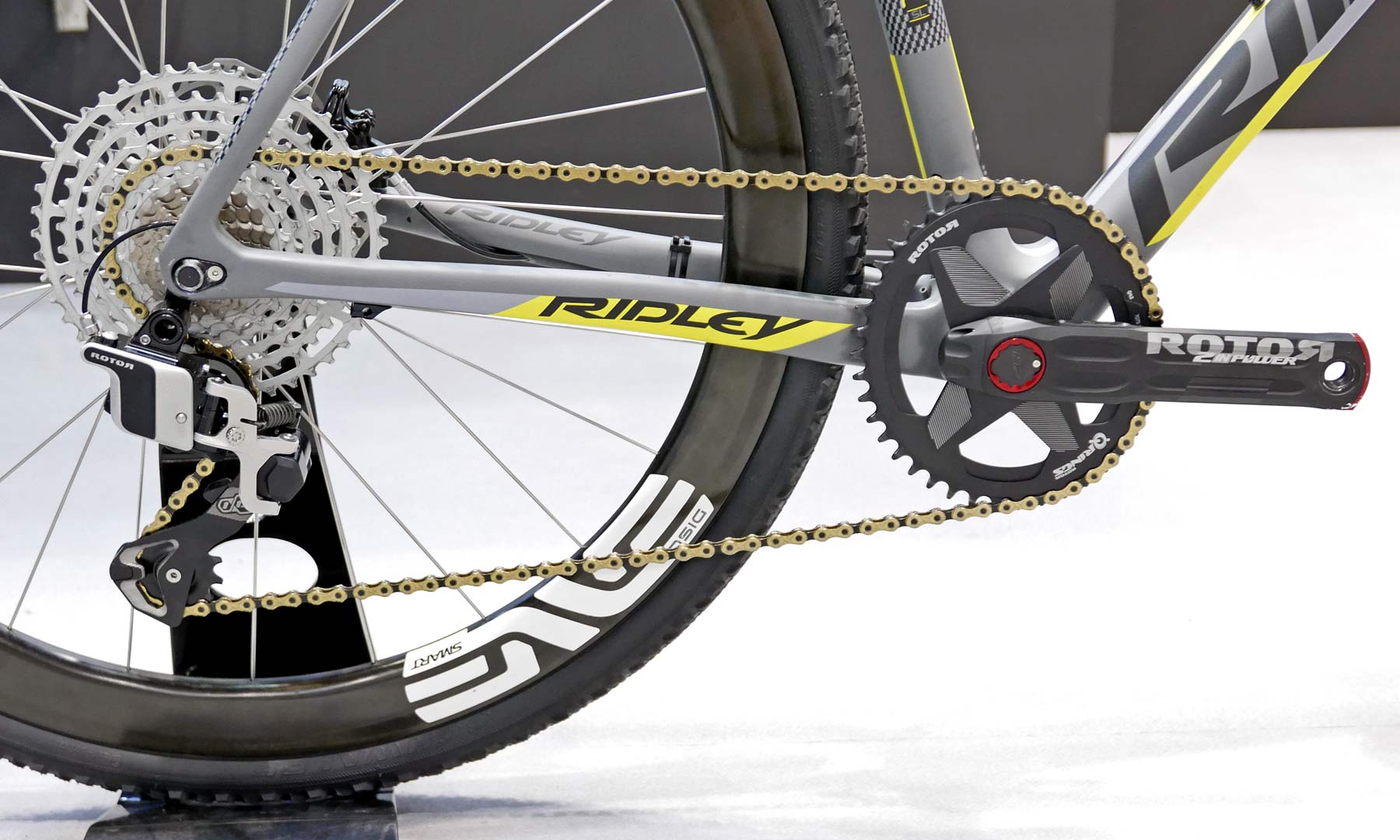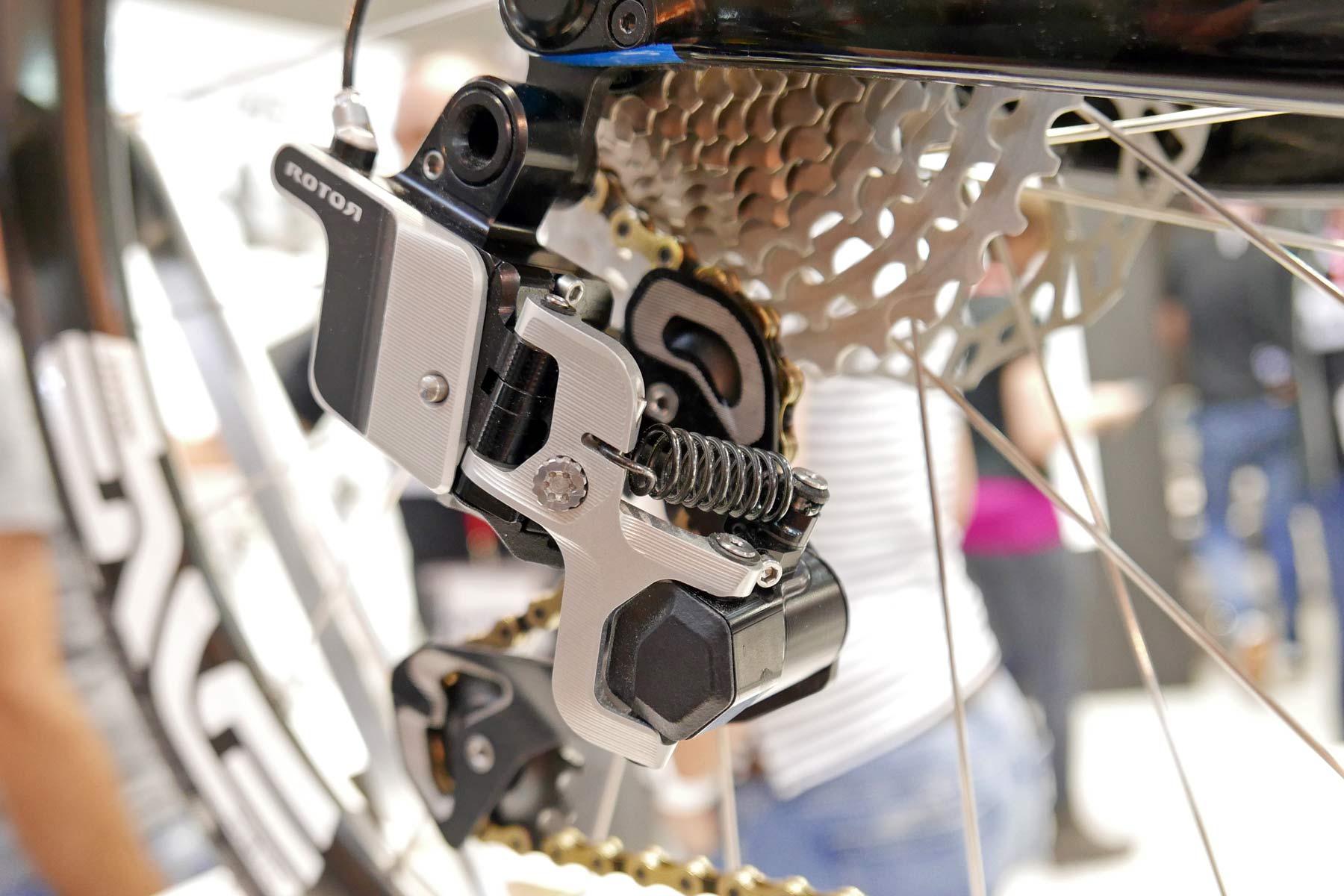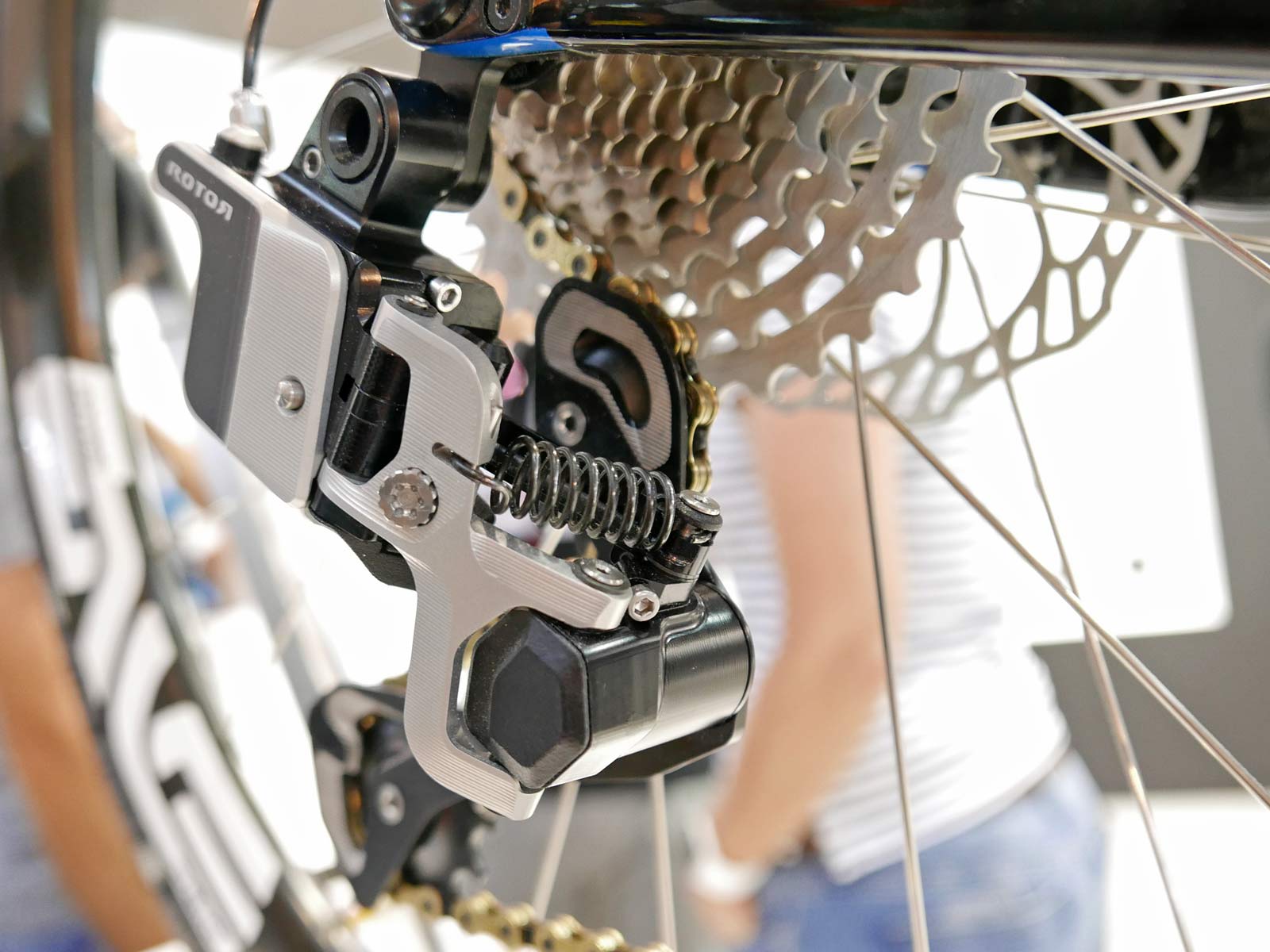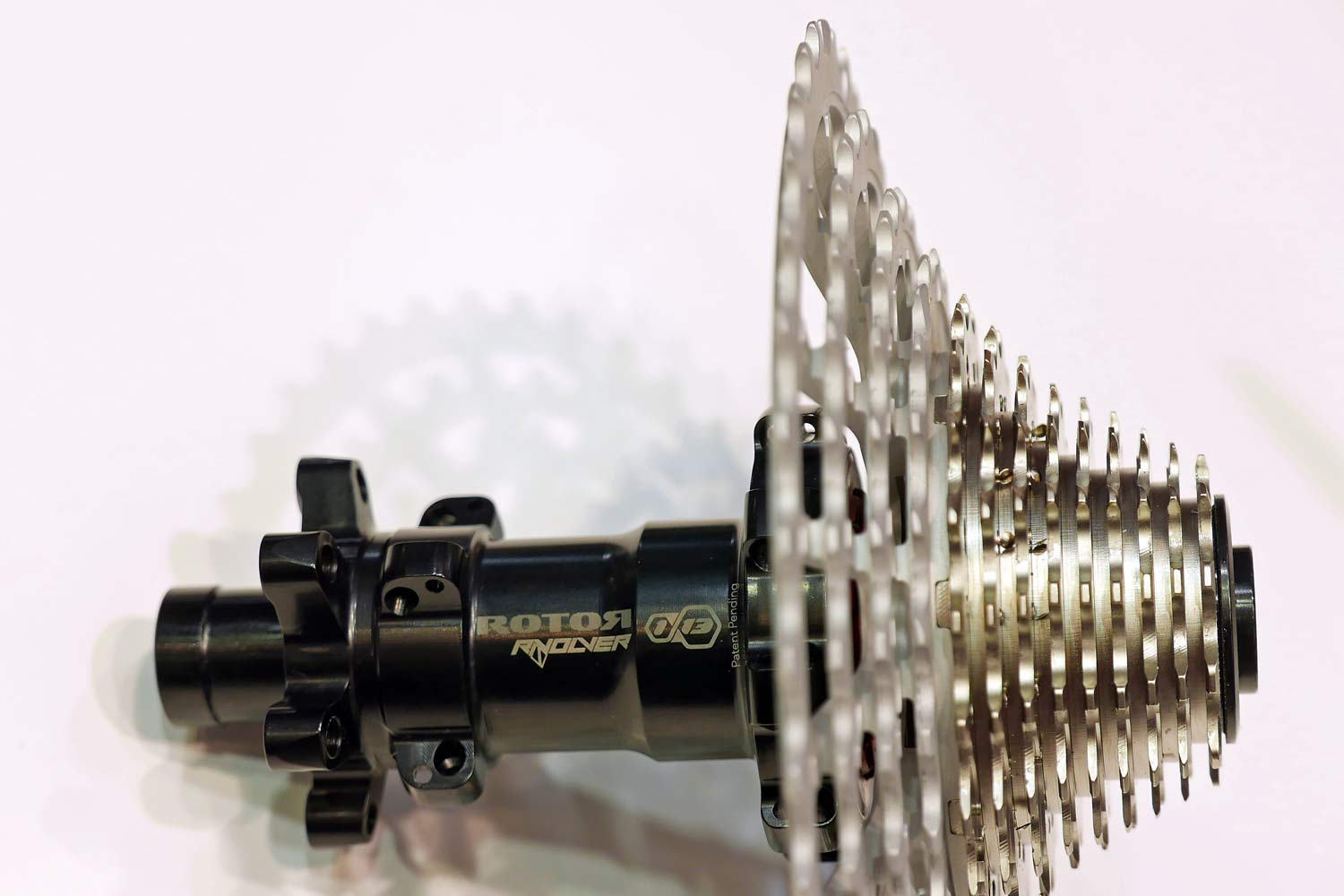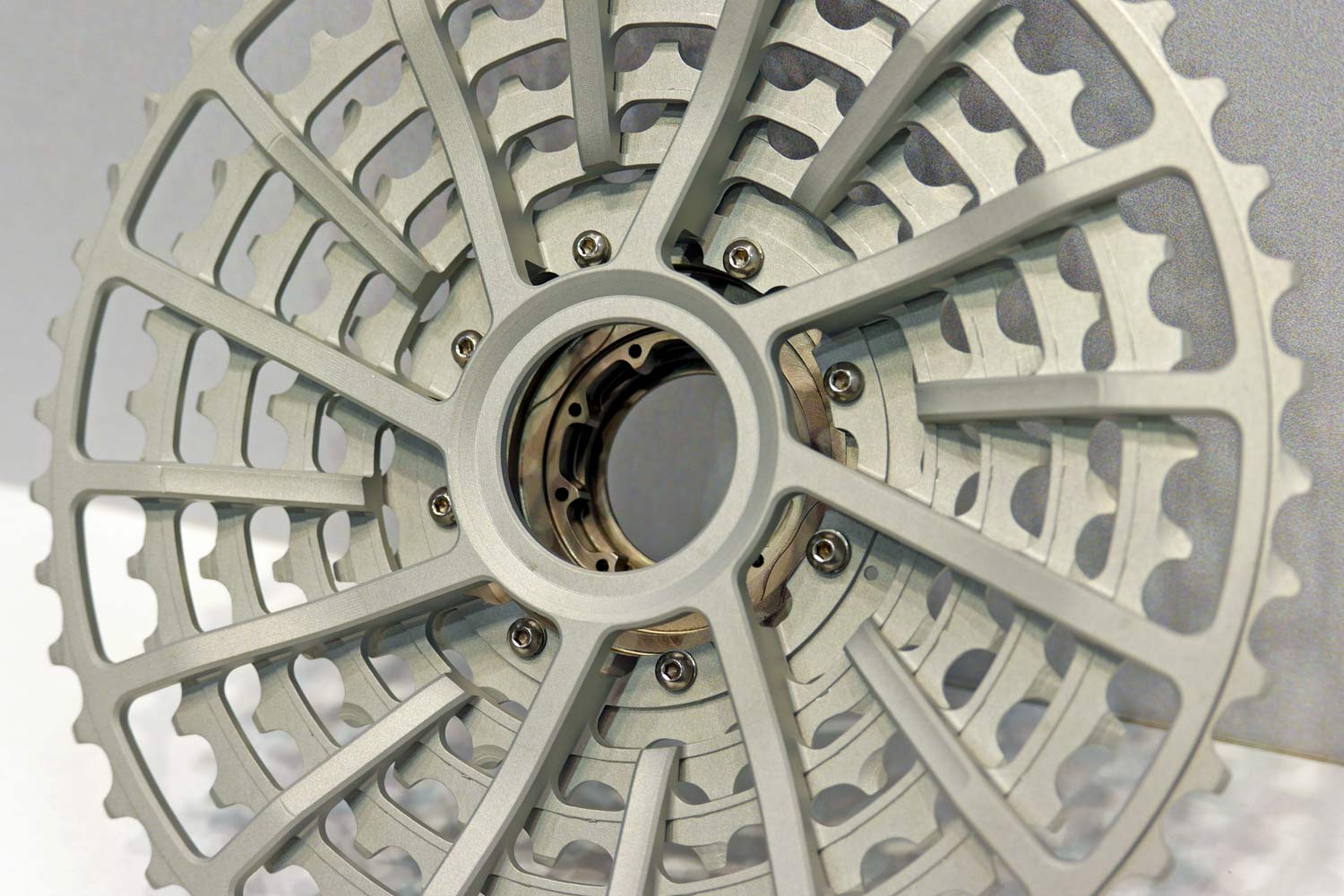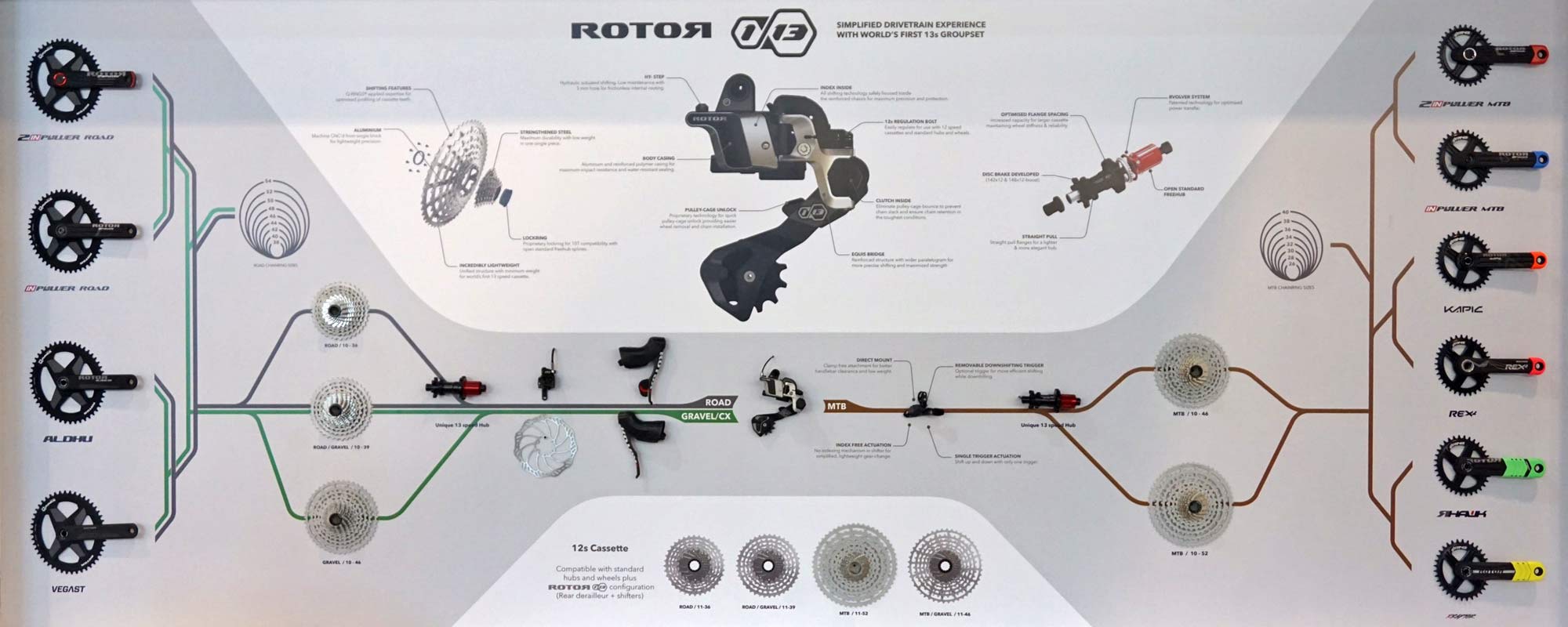Rotor takes their hydraulic shifting solution one step further with a new single ring, 13-speed groupset. Simply called 1×13, the all-new derailleur & cassette promise wide ranges, more gear options, and better optimized cadence steps. 1×13 needs a new hub, but can also be run as 12-speed on existing wheels, even using its 12-speed cassette as a lighter race option for Eagle riders.
Rotor 1×13 13-speed hydraulic single ring drivetrain
At the heart of the new 1×13 groupset is an all-new aluminum derailleur, machined in-house by Rotor in Spain. Combine that with a new range of 13-speed cassettes with tightly spaced cogs in a small machined steel cluster and a variety of larger cog clusters of machined alloy to offer ranges from 10-36 up to 10-52. The 13 gear cluster does require a new 13s specific hub that currently is only offered by Rotor’s Rvolver, although it is a simple update using a standard Shimano-style freehub body with updated hub flange spacing.
And in the meantime if you want to stick with current wheels, you can simply run the 1×13 as 12 speed, by adjusting a limit screw. Each of the four new 13 speed cassettes are also available in a 12 speed version that chops off the small 10t cog, allowing them to fit on a standard freehub body.
The shifters are a completely other story. Since the shift indexing is within the derailleur, Rotor can use their current Uno road shifter or a new direct mount trigger shifter to cover everything from road racing to mountain bike trail riding.
Tech Details
Housing all of the shift indexing within the derailleur, Rotor puts all of the brains of the system there, making the actual shifters a simple mechanisms to push fluid for the shift. That makes the entire system very modular & less dependent on the shifter and those same 3mm hydraulic lines as their current Uno road groupset.
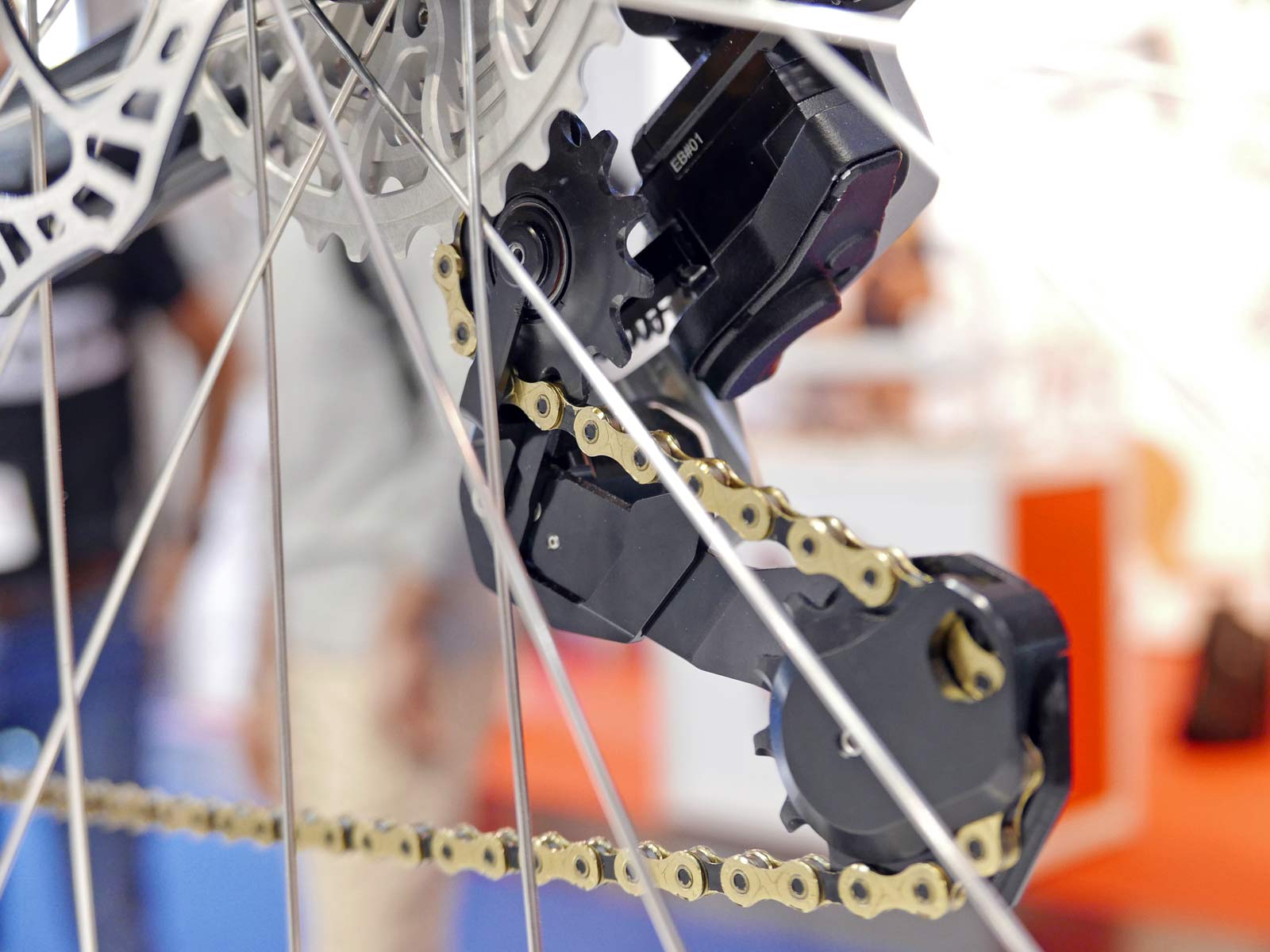 The 1×13 rear derailleur utilizes a rather unique, open pulley cage design with a large one-sided construction that essentially cantilevers the lower pulley. The upper and lower pulleys are effectively on separate arms, which leads to a release function…
The 1×13 rear derailleur utilizes a rather unique, open pulley cage design with a large one-sided construction that essentially cantilevers the lower pulley. The upper and lower pulleys are effectively on separate arms, which leads to a release function…
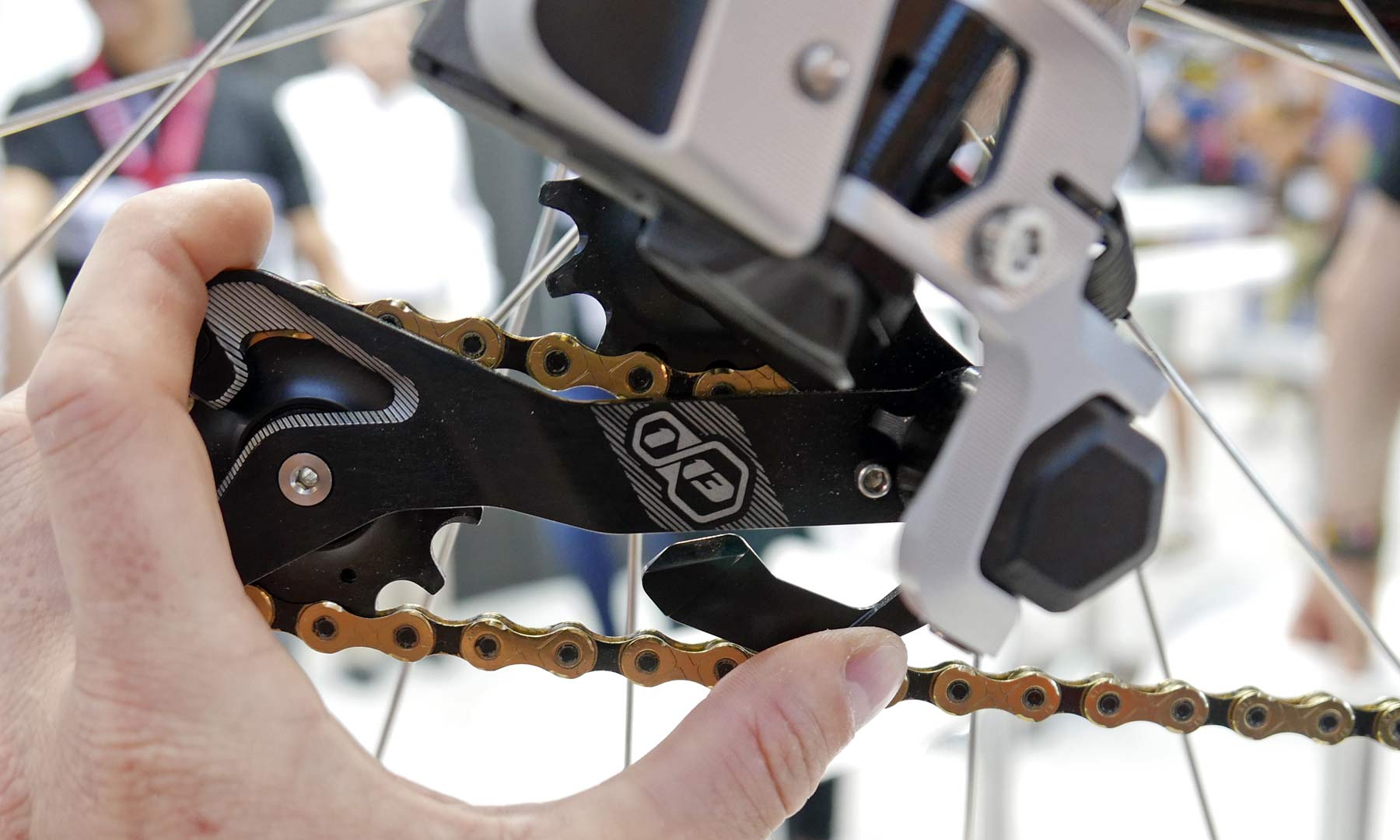 The derailleur incorporates a clutch to tension the long chain needed to wrap the biggest range 10-52t cassette. To get around Shimano & SRAM patented clutch releases, Rotor uses a simple mechanical switch on the cage that you push to disengage the pulley cage from the clutch mechanism. It is a simple & easy to do movement, but is likely going to be a messy solution in the real world as you have to press near the chain to release, and hold the lower section of the pulley cage to re-engage.
The derailleur incorporates a clutch to tension the long chain needed to wrap the biggest range 10-52t cassette. To get around Shimano & SRAM patented clutch releases, Rotor uses a simple mechanical switch on the cage that you push to disengage the pulley cage from the clutch mechanism. It is a simple & easy to do movement, but is likely going to be a messy solution in the real world as you have to press near the chain to release, and hold the lower section of the pulley cage to re-engage.
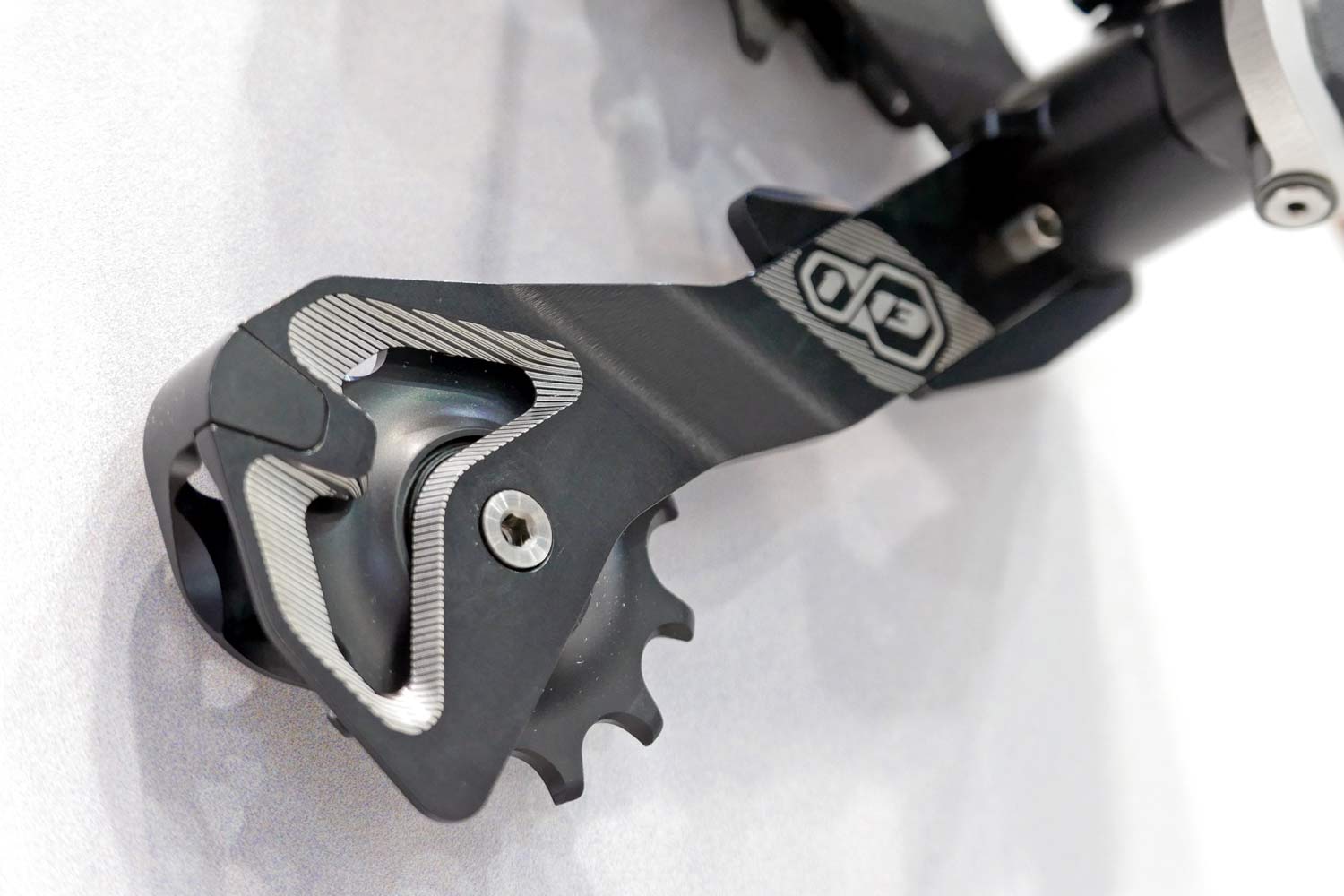 The lower pulley does incorporate an interlocking, closed lower cage with some complex machining for the lower pulley that Rotor says offers solid chain retention and quiet operation.
The lower pulley does incorporate an interlocking, closed lower cage with some complex machining for the lower pulley that Rotor says offers solid chain retention and quiet operation.
On the outside the 1×13 derailleur offers much of the same adjustability as the Uno derailleur does. The small round dot on the main body releases the shift indexing, so you can quickly drop the derailleur down to the lowest sprocket (and reset shifting after a crash.) The small knurled adjuster lets you easily dial in tune, aligning the pulleys with the desired cog. The small hex just under the derailleur mounting bolt adjusts b-tension to adjust for the wide variety of max cogs (smallest 10-36, largest 10-52 with the same length cage.) And the small hex bolt on the black lower knuckle is a limit bolt that can be used to limit the derailleur for 12 speeds to work on existing hubs.
Overall the beefier rear derailleur has a current claimed weight around 350g in order to move more straightly across the bigger cassettes, to provide needed 1x tension & security, and to survive the harsher life of off-road riding.
 The cassette is equally unique in its design, using a standard Shimano-stye body, but placing the additional 10T cog outside, off the freehub body. Rotor stuck with 12 speed spacing for compatibility and the ability to stick with a proven 12-speed chain (by KMC.)
The cassette is equally unique in its design, using a standard Shimano-stye body, but placing the additional 10T cog outside, off the freehub body. Rotor stuck with 12 speed spacing for compatibility and the ability to stick with a proven 12-speed chain (by KMC.)
Pulling the 10t cog off the freehub body, Rotor was able to offer a number of cassettes with very tightly spaced harder gears, while still offering huge range up to 520% with the widest cassette.
Rotor put a huge amount of data analysis into developing the gear ratios, effectively offering four gear combos – 10-36, 10-39, 10-46 & 10-52 – to satisfy everyone from road racing (& TT) to trail riding mountain bikers with fewer gaps than any 1x system currently on the market and matching the best of road double ranges & cadences.
The key to fit the smaller cog on the standard freehub body first starts with the single machined steel 10-16 tooth cluster, which gets a special lockring fixed to the cassette. The two-piece black lockring uses a standard tool to tighten, and reaches the extra 3mm needed to get back to the standard threads of the freehub.
All of the 12-speed spaced, but with 13 cog cassettes are machined in-house by Rotor, and are quite light. This standard road or gravel 10-39 weighed just 252g on our scale (including the fixed on lockring). The biggest 10-52 is still claimed to be just 330g. I saw a picture of that one on a scale, but Rotor says that might not be the exact final weight +/- a few grams as the optimize the alloy machining.
Yes, all of this 13-stepped goodness (craziness?) requires a new hub. Rotor’s Rvolver is the only one ready right now, but actual group availability is still a ways off, so there may be more options by then. The extra cog needs an extra 3mm of space pushing the hub flange in board that distance. On standard 12x142mm hubs, Rotor has opted for 2:1 lacing as the best solution. On their Boost 148 hubs they say the extra 6mm overall meant they could stick with standard lacing patterns.
While the hub is unique due to its spacing, it uses a completely standard free hub body that simply sits 3mm internally, away from the driveside dropout. Rotor has made this an open standard, so any other hub makers wishing to offer compatibility can simply adopt the updated flange and freehub spacing, with their current freehub bodies.
Shifters are less critical to the new system, as they can work with any of Rotor’s hydraulic groups, no matter the number of speeds. The existing Uno road shifter will pair with 1×13 perfectly, but Rotor also has this new low profile, modular direct mount mountain bike shifter also. It actually only needs one of those triggers, while the second is removable, offering an additional hand/finger position for shifting.
12 speed cassettes too!
 All of the cassettes are actually 12-speed spacing (even in 13-speed variations), making them a suitable alternate for Shimano or SRAM 12s cassettes. Each of the new sizes will be available as a lightweight 12-speed cassette, minus the 10t cog.
All of the cassettes are actually 12-speed spacing (even in 13-speed variations), making them a suitable alternate for Shimano or SRAM 12s cassettes. Each of the new sizes will be available as a lightweight 12-speed cassette, minus the 10t cog.
With the 10t machined off, the 12-speed cassettes all get a standard 11t small cog and slide onto a regular hub and freehub, with a standard lockring. Use these a light replacement cassette for other drivetrains, or as an intermediate solution to get most of the benefit of 1×13 without the need to build new wheels!
Complete Rotor 1×13 Groupsets
All of the 13 speed tech is actually confined to just the new rear derailleur, cassette, and hub. But that means you can pick and choose from the rest of the Rotor lineup to build your complete bike. Most all of the Rotor cranks & power meters are compatible, with Rotor offering direct mount 1x rings in two tooth even steps in pretty much any size you could want (26-54T.) Pick the shifters that work for you, then the brakes (although you’ll have to look elsewhere for MTB brakes) and off to riding.
Final weights aren’t really nailed down just yet, but.. basically the new group comes out about 35g heavier than a current Uno road group, while adding a clutch and wider gear range. On the road that makes for one of the lightest drivetrain options available. We suspect on the mountain bike the savings will look even more impressive.
Pricing & Availability
The complete new 1×13 groupsets are slated for availability at the start of 2019 (Q1). Pricing isn’t set yet, as Rotor has a bit more analysis of their in-house manufacturing & optimization to set up. But they did confirm that the target looks like they will deliver a complete groupset for slightly lower cost than their complete Uno group, by virtue of having a more complex rear derailleur, but dropping the front one.
Now we just need to get on a group and see how it rides!
